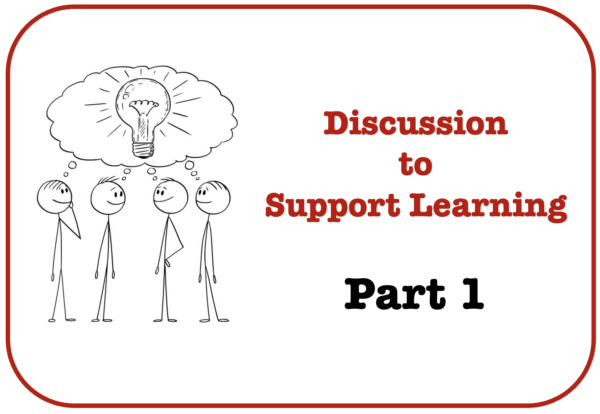Discussion to Support Learning, Part 1

This is the first of a three-part series of posts focused on using discussion to support learning. Discussion supports learning in all subjects because it helps students think deeply and process information instead of just receiving it. Discussion-based learning is an alternative to having students memorize and recite information presented by the teacher or found in text. The guidance report Improving Literacy in Secondary Schools (Evidence for Learning, 2020, p. 24) explains, “Talk is a powerful tool for learning and literacy. It can improve reading and writing outcomes, enhance communication skills, and increase students’ understanding across the curriculum.”
Text-Based Discussion
While discussion is associated with all around learning success and can support learning from anything that is read, said, or done in the classroom, much of the research about discussion and related instructional recommendations is focused on discussion about text and its role in supporting reading comprehension. In addition to independently using reading comprehension strategies such as making predictions, summarizing, and taking notes, discussion provides a way to help students comprehend and learn from text.
The guide Evidence-Based Reading Instruction for Adolescents in Grades 6-12 (Patrick & Acosta, 2024, pp. 42-43) points out:
“Class discussions, when thoughtfully conducted, are an important tool to enhance reading comprehension, foster critical thinking, and prepare students for college and their careers. Discussions can take place in all content classes and are excellent vehicles to increase the participation of students with disabilities. Recent research suggests that engaging students in effective in-depth discussions in combination with a close reading of a text is one of the most significant ways to improve comprehension for older readers (Pearson et al., 2020) including for English learners… for English learners, small group discussions with sentence starters and frames can support students in engaging in in-depth discussions (Proctor et al., 2020).”
A text-based discussion is an open-ended, collaborative exchange of ideas among teachers and students that provides opportunities for students to become more critical thinkers as they engage deeply with the text and construct meaning along with others. In a discussion about text, participants present and defend individual interpretations and points of view, reflect on and respond to the ideas of others, and use text content, background knowledge and reasoning to support interpretations and conclusions, in an effort to build their knowledge and understanding of the text (Kamil et al., 2008; Wilkinson & Nelson, 2020).
Text-based discussions are supported and driven by open-ended questions. Teachers identify some aspect of the text as a focus and use thought-provoking questions or prompts to guide student conversations about that focus.
Research Supporting Discussion
Decades of research have demonstrated that high-quality discussion that incorporates different perspectives and background knowledge related to the content in text is effective for supporting text comprehension and learning. Further, discussion has direct and positive influence on students across a wide range of subjects. (Kamil et al., 2008; Murphy et al., 2009; Resnick et al., 2015; Murphy et al., 2016). Research also indicates that discussions are especially productive when students are asked to argue constructively about the content in text, explaining, elaborating, and defending their positions while considering the perspectives of others (Reznitskaya, Hsu, & Anderson, 2015; Wilkinson & Nelson, 2020).
One important research finding is that the quality of talk is more important for supporting reading comprehension than the quantity of talk (Wilkinson & Nelson, 2020). That is, increases in the amount students talk do not result in increases in student comprehension. Rather, talk that is structured and focused, yet not dominated by the teacher, is necessary to support comprehension. This includes students discussing texts using open-ended questions for extended periods of time, prompted by the teacher or other students. It also includes the teacher or students incorporating the ideas of others into their questions and building on each other’s ideas.
Another finding is that while all students benefit from classroom discussion activities, discussion appears to be particularly beneficial for students with lower reading ability, possibly because students with higher reading ability already possess the skills needed to comprehend text (Wilkinson & Nelson, 2020). Based on research findings related to discussion-based interventions, Swanson and colleagues (2019) suggest asking questions and using text-based discussion as a method for engaging students who struggle to read and understand text.
Discussion Formats
Many types of discussion activities can be used in the classroom and the format can be whole-class, small-group, or partner discussion. Teachers should choose activities and a format that aligns with their discussion goals and will engage students. Resnick, Asterhan, and Clarke (2018, p. 29) provide the following descriptions of three common discussion formats:
- Teacher-Led Classroom Dialogue: The teacher guides discussion in which all students are invited to participate. This includes allocating turns. The teacher guides the content of the discussion by probing students’ answers, commenting, adding information, clarifying, verifying, and encouraging participation by all. Everyone is together and benefits from access to the thinking of the whole group. The advantage of this format is that the teacher guides students through the content and knowledge, orchestrating the social interaction. The disadvantage is that only one person can speak at a time, which may lead to low participation rates.
- Small-Group, Student-Led Discussions: The teacher divides students into groups of 3-6 to discuss an assigned topic. Typically, the teacher makes rounds to monitor each group’s progress and, when needed, to offer support. Compared to teacher-led classroom dialogue, small-group peer discussions have more student-generated explanations and reasoning, and more student participation overall. Some students may be more comfortable sharing to a small group of peers rather than the whole class. Also, small-group discussion prior to a whole-class discussion can provide an opportunity for students to think through before-hand what they will contribute to the larger discussion. However, if students are still developing their discussion and collaboration competencies, and the teacher is not present for all discussions, the quality of the dialogue may not be as high, and a few students may dominate the discussion.
- Partner Talk: The teacher poses a question and asks students to discuss for a few minutes with a partner. After that, the teacher asks single members of the pairs to share what they discussed. The advantage of this format is that it combines teacher-led classroom dialogue with episodes in which all students – not just a few – can think about, generate solutions, and engage in discussion. This is especially helpful for students who are not comfortable participating in large-group discussions. Partner talk can serve as an opportunity to practice what students might say in a whole-group discussion. The disadvantage is that partner talk typically is brief.
Instructional Suggestions
The research guide Improving Adolescent Literacy: Effective Classroom and Intervention Practices (Kamil et al., 2008) offers evidence-based suggestions for engaging students in high-quality discussions of text in grades 4 to 12. The guide notes that it is important to establish a non-threatening and supportive environment that includes the teacher emphasizing and modeling acceptance of diverse viewpoints and discouraging criticism and negative feedback on ideas. It also suggests teachers help students participate by calling on students who may not otherwise contribute while asking questions they know these students can answer.
View the additional suggestions below from this guide (pp. 23-25):
- Carefully prepare for the discussion: Teachers should look for text that is engaging for students and include content that can encourage discussion and have multiple interpretations. Teachers should develop questions that can stimulate students to think reflectively about the text and make high-level connections or inferences. These are questions that engage a reader to wonder about rather than questions designed simply to determine what students have learned from the text.
- Ask follow-up questions that help provide continuity and extend the discussion. Follow-up questions should sustain the discussion and help students consider a different interpretation, an explanation of reasoning, or an identification of content from the text that supports the student’s position.
- Provide a task, or a discussion format, that students can follow when they discuss text together in small groups. Use a format where students take turns playing various roles, such as leading the discussion, predicting what the section might be about, identifying words that are confusing, and summarizing.
- Develop and practice the use of a specific discussion protocol. Identify a specific set of steps for participation in discussion. (see the Accountable Talk framework later in this module)
Part 2 of this series will provide suggestions for planning discussions, including preparing questions that are used to begin and sustain a discussion. Part 2 will also offer suggestions for using discussion norms that enable all students to participate in discussions. Part 3 of the series will address academically productive talk, including details about the Accountable Talk framework developed by researchers at the University of Pittsburgh. Suggestions for facilitating high-quality discussions will be shared, including teacher and student Talk Moves.
Part 1 References
- Evidence for Learning (2020). Improving literacy in secondary schools. Sydney: Evidence for Learning.
- Kamil, M.L., Borman, G.D., Dole, J., Kral, C.C., Salinger, T., and Torgesen, J. (2008). Improving adolescent literacy: Effective classroom and intervention practices: A Practical Guide (NCEE #2008-4027). Washington, DC: National Center for Education Evaluation and Regional Assistance, Institute of Education Sciences, U.S. Department of Education.
- Murphy, P. K., Wilkinson, I. A. G., Soter, A. O., Hennessey, M. N., & Alexander, J. F. (2009). Examining the effects of classroom discussion on students’ high-level comprehension of text: A meta-analysis. Journal of Educational Psychology, 101, 740–764.
- Murphy, P. K., Wilkinson, I. A. G., Soter, A. O., & Firetto, C. M. (2016). Instruction based on discussion. In R. E. Mayer & P. A. Alexander (Eds.), Handbook of research on learning and instruction (2nd ed.). New York, NY: Routledge.
- Patrick, J.D., & Acosta, K. (2024). Evidence-Based Reading Instruction for Adolescents in Grades 6-12 (Document No. IC-13b). University of Florida, Collaboration for Effective Educator, Development, Accountability, and Reform Center.
- Pearson, P. D., Palinscar, A. S., Biancarosa, G., Bernman, A. I. (Eds.). (2020). Reaping the Rewards of the Reading for Understanding Initiative. National Academy of Education.
- Proctor, C. P., Silverman, R. D., Harring, J. R., Jones, R. L., & Hartranft, A. M. (2020). Teaching bilingual learners: Effects of a language‐based reading intervention on academic language and reading comprehension in grades 4 and 5. Reading Research Quarterly, 55(1), 95–122.
- Resnick, L. B. C, Asterhan, C. S. C., & Clarke, S. N. (2015). Introduction: Talk, Learning, and Teaching. In: L. B. Resnick, C. S. C. Asterhan & S. N. Clarke (Eds), Socializing Intelligence through academic talk and dialogue (pp. 1-12). Washington, DC: AERA.
- Resnick, L.B., Clarke, S., & Asterhan, C.S.C. (2018). Accountable talk: Instructional dialogue that builds the mind. Educational Practices, 29 (7).
- Reznitskaya, A., Hsu, J. Y., & Anderson, R. C. (2015). Using inquiry dialogue to promote the development of argument skills: Possibilities, challenges, and new directions. In S. R. Parris & K. Headley (Eds.), Comprehension instruction: Research-based best practices (3rd ed., pp. 29–44). New York, NY: Guilford.

 Joan Sedita is the founder of Keys to Literacy and author of the Keys to Literacy professional development programs. She is an experienced educator, nationally recognized speaker and teacher trainer. She has worked for over 35 years in the literacy education field and has presented to thousands of teachers and related professionals at schools, colleges, clinics, and professional conferences.
Joan Sedita is the founder of Keys to Literacy and author of the Keys to Literacy professional development programs. She is an experienced educator, nationally recognized speaker and teacher trainer. She has worked for over 35 years in the literacy education field and has presented to thousands of teachers and related professionals at schools, colleges, clinics, and professional conferences.
The emphasis on structured discussions is spot on, especially for improving comprehension. Do you think technology, such as AI or discussion platforms, could help facilitate more equitable participation in larger classrooms or remote settings?
I really like how you pointed out that discussion helps students think deeply about the content instead of just memorizing it. It’s such an important shift from the traditional ‘sit and listen’ approach to learning!
I completely agree with how essential discussions are for helping students process and internalize information. It’s so much more effective than simply memorizing facts. Text-based discussions, in particular, seem like a powerful tool to engage students and deepen their comprehension.
It’s so true that discussion helps students move beyond memorization! I’m curious—what are some effective ways to encourage more student-led discussions in a typical classroom setting?
I appreciate the emphasis on discussion as a tool for deeper learning rather than just surface-level memorization. It’s especially relevant in secondary classrooms where students are ready to engage more critically—structured talk can really bridge the gap between comprehension and expression. I’m looking forward to seeing how future posts break down strategies for making discussions more purposeful.
This literacy discussion guide is incredibly practical! Your “Three-Step Framework” for meaningful classroom conversations provides such clear structure. The sentence stems you’ve included are perfect scaffolds for students developing discussion skills. That video demonstration of a Socratic seminar in action really brings your strategies to life. The differentiation tips for various proficiency levels show thoughtful consideration of diverse learners!
This discussion framework is pedagogically brilliant! Your “Three-Step Framework” creates accessible entry points for all learners. The sentence stems empower hesitant students beautifully. That video demonstration of Socratic seminars in action brings theory to life. Your differentiation strategies ensure every voice matters!
This post does a great job highlighting how structured, text-based discussions can deepen comprehension and critical thinking. I especially appreciate the emphasis on quality over quantity of talk and the practical breakdown of discussion formats. Excited to see the upcoming parts of this series!
Student-led discussions allow students to share personal connections to the topic on hand. This is often a safe way for my students on IEP to share without feeling anxiety about “getting the correct” answers when participating in small group discussions.
I agree! This is a great way for students to connect with a text. When students connect with something, they are also better able to remember it.
I appreciate the focus on using discussion as a way to promote deeper learning rather than simple memorization. This approach is especially valuable in secondary classrooms, where students are ready to think critically and share their ideas. Structured discussions can help connect understanding with communication. I’m interested to see future posts that explore specific strategies for making classroom discussions more intentional and effective.
I love that this PD and this article in particular emphasized how discussion is a tool to deepen learning rather than just surface-level memorization. In secondary classrooms, this is an essential tool because students are more eager to engage and think critically. One way I would use it structured dialogue is to bridge the gap between comprehension and expression. I’m looking forward to seeing how future posts break down strategies for making discussions more purposeful.
I love the idea of letting the students have different roles at different times to help them connect with the material on different levels. Such as them playing various roles, such as leading the discussion, predicting what the section might be about, identifying words that are confusing, and summarizing. I think once they are in the space of actually having a hands on role it becomes more embedded than just surface in the moment information.
I really like how this post breaks down the power of discussion in helping students think deeper and really understand what they’re reading. The point about quality of talk mattering more than quantity really stood out. I also like the examples of different discussion formats—it makes it easy to picture how to try them out in class. Can’t wait to read Part 2 and get ideas for creating good questions and discussion norms!
I agree that small group discussion helps students who would not otherwise engage in any type of discussion. While walking around the room I have difficulty keeping the 7th graders on track. The minute I leave they revert back to talking about everything else except what we are working on. I do not like reminding them over and over to stay on task.
This article nails it by showing that discussion is key to deeper comprehension. I love how it combines reading strategies with collaborative dialogue to foster learning. It reminds me of those engaging group discussions in class.
Really enjoyed reading about these text-based discussion techniques. It shows how conversation can be a strong tool for blending knowledge with creativity. The ideas here motivate me to explore more interactive learning methods in my classes.
I’ve always thought that discussing texts in class really helps to understand and retain information better. I’m going to try to integrate this more often into my classes
I never really thought about how much structured discussion can help, especially for those struggling with reading.